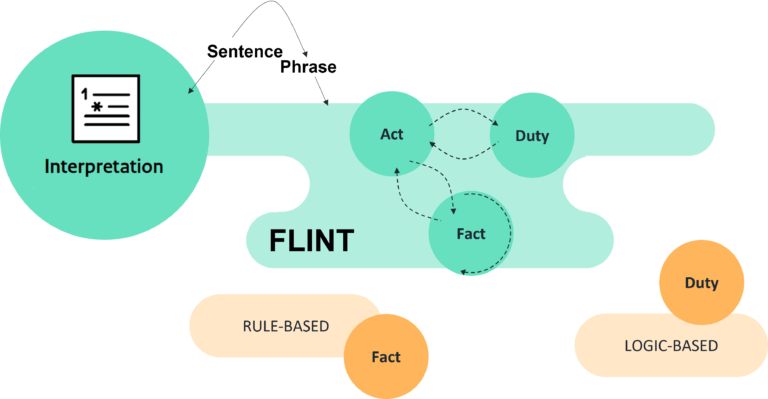Compliance is no longer just a box to check. For many organizations, it shapes business operations, influences strategy, and affects competitiveness. However, as legal requirements multiply and become increasingly complex, traditional compliance methods often fall short. This isn’t just about making compliance easier. It’s about revolutionizing how organizations interact with the law.
Regulations, however, are not designed to be obstacles. They should serve as effective tools to guide and inform business decisions. That’s why we introduce norm engineering as a different approach. Norm engineering turns dense legal texts into structured, machine-readable models that systems and people can work with. This isn’t just about keeping up with regulations. It’s about rethinking how organizations interpret and apply the law with clarity, precision, and control.
The evolution of regulatory technology
From manual to digital
Compliance used to mean legal teams manually digging through laws, piecing together what applied where, and hoping nothing slipped through the cracks. It was slow, repetitive, and left a lot of room for interpretation and error.
The shift to Regulatory Technology (RegTech) was a significant milestone. Early automation tools began taking over routine tasks, such as regulatory monitoring, transaction monitoring, and ensuring data privacy protocols are followed. It was a significant leap forward, but it still had limitations. Most of these solutions worked in isolation and couldn’t connect the dots across departments or jurisdictions, and struggled to keep up with change.
That’s where Norm Engineering enters the picture. Instead of trying to patch over complexity with siloed tools, it tackles the root of the problem: the legal text itself. By turning regulations into structured, machine-readable formats, norm engineering makes them usable across multiple jurisdictions, frameworks, and teams.
The rise of norm engineering
As regulations multiplied and became more intertwined, it became clear that traditional automation solutions which work in silos could only take us so far. They helps automate tasks, but it didn’t fundamentally change how organizations understand or apply the rules.
Instead of treating legal texts like static documents, norm engineering breaks them down into components that software can actually work with. By transforming rules, conditions, and logic into machine-readable formats, we make it possible to automate not just what needs to be done, but when, why, and under what conditions.
The result? Clearer decisions, fewer errors, and a regulatory process that scales across borders and systems.

Fundamentals of norm engineering
Understanding norms and grounds
To understand norm engineering, we need to grasp two key ingredients: norms and grounds. Think of them as the “what” and the “when” of a rule.
- Norms are standards or rules. They tell us what must or must not be done.
- Grounds are the conditions that trigger these rules. They specify when and how that rule applies.
Now, it still sounds a bit abstract. So let’s make it more relatable. Imagine your workplace has a rule: “If it’s your birthday, you must bring cake for the team.”
- The norm is the rule: you must bring cake.
- The ground is the condition: it’s your birthday.
This relationship between norms and grounds enables organizations to interpret and apply rules precisely. In regulatory terms, it’s the difference between applying the right rule at the right time. Otherwise, we get buried in red tape and confusion.
How norm engineering translates legal texts
Legal texts are often long, dense, and filled with abstract language. Computers don’t understand nuance, ambiguity, or legal jargon. Therefore, our goal is to translate legal norms into structured, machine-readable formats so systems can interpret and apply them consistently and accurately. The norm engineering process relies on:
- Ontologies: These act like a map of legal concepts, showing how different terms and ideas relate to each other.
- Data models: These provide a standardized structure to organize all the legal information.
- Standardization protocols: These ensure everyone follows the same rules when interpreting and applying regulations.
At its heart, Norm Engineering uses a common framework, FLINT (Formal Language for the Interpretation of Norms and Theories), to tame the wild variety of legal texts. FLINT provides both a methodology and a taxonomy that:
- Normalizes language: it brings different legal terms into a single vocabulary.
- Unifies entities: it identifies and standardizes who’s doing what (people, organizations, goods, etc.).
- Structures rules: it maps out the relationships between actions, conditions, and obligations.
Developed in partnership with TNO and the University of Amsterdam, FLINT translates social, ethical, and legal norms into a format that’s readable by computers and legal experts.
A pocket guide to FLINT: acts, facts & duties
FLINT breaks every rule down into three simple pieces:
- Acts – what happens (e.g., “I sell you a car”)
- Facts – the conditions under which acts occur (e.g., “The car is my property”)
- Duties – the obligations created by those acts and facts (e.g., “You must pay me,” “I must hand over the car”)
Putting it all together, a rule like “You must register your vehicle within 30 days” becomes:
- Act: You register the vehicle
- Fact: You own a newly purchased car
- Duty: Registration must be completed within 30 days

The potential of norm engineering
The value of norm engineering lies in two powerful areas:
- Translating existing rules
It enables the conversion of legislation, regulations, and policies into clear, machine-readable logic. This creates a solid foundation for automation and consistency in how rules are interpreted and applied.
- Building better user experiences
With structured norms, organizations can develop applications that reduce compliance overhead, improve transparency, and make regulatory content easier to navigate. This means increasing accessibility and understanding, and supporting the management and modernization of the regulatory corpus.
Key benefits
Efficiency and accuracy: Norm engineering automates rule interpretation and application, reducing repetitive manual work. Compliance teams can shift their focus from routine checks to handling exceptions and high-impact decisions. Automation also reduces human error, resulting in more reliable and consistent compliance.
As AI continues to evolve, it can further enhance these processes by learning from patterns, predicting rule conflicts, and accelerating decision-making in complex regulatory environments.
Scalability across jurisdictions: Managing compliance in a single country is tough. Doing it across dozens? That’s a full-time headache. Norm engineering solves this by using standardized models that can be applied across different legal systems.
Better, faster decisions: By clearly linking norms (the rules) and grounds (the conditions under which they apply), norm engineering gives organizations a sharper understanding of how specific regulations affect specific situations.
This enables quicker, more confident decision-making, reduces compliance risks, and helps everyone, from legal teams to business owners, to make context-aware choices.
Ready to rethink compliance?
Norm engineering isn’t just another tech upgrade. It’s a new approach that promises to open up a new era of regulatory technology. By shifting from manual interpretation to structured, machine-readable models. It changes how organizations interact with the law: faster, clearer, and far more scalable.
As regulatory complexity grows, the old ways simply won’t keep up. The organizations that thrive will be the ones that embrace smarter, more adaptive approaches, and norm engineering offers just that.









